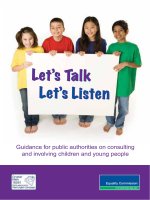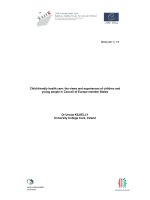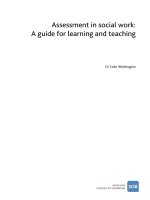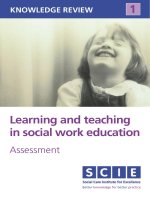teaching learning and assessment communication skills with children and young people in social work education
Bạn đang xem bản rút gọn của tài liệu. Xem và tải ngay bản đầy đủ của tài liệu tại đây (1.13 MB, 215 trang )
KR12
Teaching, learning and assessing
communication skills with children and young
people in social work education
SCIE Knowledge reviews are designed to provide social
work educators and students with the resources to improve
the teaching and learning on qualifying social work
programmes.
This knowledge review is one of a series supporting the new
social work degree. It follows a previous SCIE knowledge
review, Teaching and learning communication skills in social
work education, which identified the need to examine
communication skills with children in more detail. The
intended audience is primarily social work educators and
students.
This publication is available in an
alternative format upon request.
Social Care
Institute for Excellence
Goldings House
2 Hay’s Lane
London SE1 2HB
tel 020 7089 6840
fax 020 7089 6841
textphone 020 7089 6893
www.scie.org.uk
KNOWLEDGE REVIEW Teaching, learning and assessing communication skills with children and young people in social work education
DECEMBER 2006
SOCIAL WORK EDUCATION KNOWLEDGE REVIEW 12
Teaching, learning and assessing
communication skills with children and
young people in social work education
SOCIAL WORK EDUCATION KNOWLEDGE REVIEW 12
Teaching, learning and assessing
communication skills with children and
young people in social work education
Barry Luckock, Michelle Lefevre, David Orr, Mary Jones,
Ruth Marchant and Karen Tanner
i
SOCIAL WORK EDUCATION
First published in Great Britain in December 2006
by the Social Care Institute for Excellence
© University of Sussex 2006
All rights reserved
Written by Barry Luckock, Michelle Lefevre, David Orr, Mary Jones,
Ruth Marchant and Karen Tanner
ISBN-10 1-904812-14-7
ISBN-13 978-1-904812-14-2
Produced by The Policy Press
Fourth Floor, Beacon House
Queen’s Road
Bristol BS8 1QU
tel 0117 331 4054
fax 0117 331 4093
www.policypress.org.uk
This report is available in print and online
www.scie.org.uk
Social Care Institute for Excellence
Goldings House
2 Hay’s Lane
London SE1 2HB
tel 020 7089 6840
fax 020 7089 6841
textphone 020 7089 6893
www.scie.org.uk
Front cover photograph kindly supplied by www.JohnBirdsall.co.uk
ii
CONTENTS
Foreword
Acknowledgements
Executive summary
vi
vii
viii
1
Introduction
1.1 Context
1.2 Knowledge review
1.3 Defining communication
1.4 Initial consultations and differing perspectives
1
1
1
3
5
2
Research review
7
2.1 Methodology
7
2.1.1 Search strategy
7
2.1.2 Screening and selection process
8
2.1.3 Mapping and analysis process
10
2.2 Research message 1: What counts as effective
11
communication with children in social work
practice?
2.2.1 Sources of evidence
11
2.2.2 Thematic analysis
12
2.2.2.1 Conceptualising ‘skilled
12
communication’ in social work
practice
2.2.2.2 Inhibitors of communication
13
between social workers and children
2.2.2.3 Identifying the core conditions
17
and specific aspects of effective
communication between children
and social workers
2.2.2.4 Core condition 1: Ethical and
18
emotional engagement in social work
2.2.2.5 Core condition 2: Child-centred
23
communication
2.2.2.6 Core condition 3: Understanding 25
the distinctive nature of child
communication
2.2.2.7 Specific aspects of skilled
25
communication
iii
SOCIAL WORK EDUCATION
2.3 Research message 2: What constitutes effective 32
teaching, learning and assessment of communication
skills with children and young people in qualifying
social work education?
2.3.1 Sources of evidence
32
2.3.2 Thematic analysis
33
2.3.2.1 Conceptualising ‘skilled
33
communication’ with children in
social work education
2.3.2.2 Learning aims and outcomes
35
and teaching methods
2.3.2.3 Impact and effectiveness of
45
teaching, learning and assessment
of communication skills with children
2.3.2.4 In summary
51
3
iv
Practice survey
53
3.1 Aims and objectives
53
3.2 Challenge of programme development
53
3.3 Survey design
55
3.4 Sampling and data collection
56
3.4.1 Social work education survey
56
3.4.2 Allied professionals survey
57
3.5 Data analysis
58
3.6 Results and representativeness of sample
59
3.6.1 Survey of social work programmes
59
3.6.2 Survey of allied professionals
61
3.7 Findings 1: Survey of social work programmes
62
3.7.1 Curriculum design
63
3.7.2 Learning outcomes and teaching methods 72
3.7.2.1 Learning outcomes
73
3.7.2.2 Teaching methods
85
3.7.3 Involvement of children
90
3.8 Findings 2: Survey of allied professions
98
programmes
3.8.1 How communication skills with children are
thought about in professional education
Contents
3.8.2 Communication with children as a basic
and fundamental skill
3.8.3 Communication with children as as
advanced level skill
3.8.4 Communication with children as a
therapeutic tool
3.8.5 How communication skills with children
are taught and assessed in allied
professional education
99
99
100
100
4
Summary of knowledge review findings and
105
implications for curriculum development
4.1 Summary of findings
105
4.2 Implications for curriculum development
106
4.3 Identifying a children’s lead and a ‘whole
107
programme’ approach
4.4 Reviewing assumptions about, and
108
arrangements for, teaching and assessing generic
and specialist skills
4.5 Clarifying and integrating aims, learning
109
objectives and teaching and assessment methods
4.6 In conclusion
111
5
References
113
Appendix 1: Search terms and databases
135
Appendix 2: Screening and selection process
165
Appendix 3: Keywording strategy
169
Appendix 4: Practice survey questionnaire:
social work educators
173
Appendix 5: List of professional bodies contacted
for secondary survey
179
Appendix 6: Allied professionals: interview format
181
Appendix 7: Summary of social work practice
in-depth review studies and data extraction
183
Index
197
v
SOCIAL WORK EDUCATION
Foreword
This knowledge review is one of a series supporting the new social work
degree. It follows a previous Social Care Institute for Excellence (SCIE)
knowledge review, Teaching and learning communication skills in social
work education, which identified the need to examine communication
skills with children in more detail. The intended audience is primarily
social work educators and students.
Children who were consulted for this review said that they wanted
social workers to do certain things for them such as listen, explain, and
get things done, and, as one small child said approvingly of her social
worker:
‘If I was confused she would unconfuse me.’
They also wanted social workers to behave in an understanding way, to
be fair, kind, trustworthy and reliable.
Talking with and listening to children is a core social work skill, and
we hope that this review will put the topic firmly on the agenda, and
be a valuable resource for social work educators, students and all those
concerned with training the next generations of social workers. We also
hope the review will form the basis of further curriculum development
and teaching and assessment methods in this aspect of practice.
Other reviews in this series have included work on the teaching and
learning of law, partnership working and assessment skills. Future work
will include resources on interprofessional education and the learning
and teaching of human growth and development.
We would like to thank the authors who undertook this review, which
has made a valuable contribution to a previously overlooked topic.
Mary Sainsbury
Practice Development Manager
Social Care Institute for Excellence
vi
Acknowledgements
Acknowledgements
Many people supported us in our work on this knowledge review. We
would like to take this opportunity to thank them for their kindness and
generosity. In particular we appreciated the contributions made to review
design, data collection and analysis by Judy Sebba, Elaine Sharland,
Sharon Otoo and Ainslie Smith.
Advisory group
Jo Bates, Brighton and Hove City Council
Sue Berelowitz, West Sussex County Council
Margaret Boushel, Barnardo’s
Sara Bragg, University of Sussex
Jo Bridgeman, University of Sussex
Jenny Clifton, West Sussex County Council
Michael Fielding, University of Sussex
Julia Goldbart, Manchester Metropolitan University
Angie Hart, University of Brighton
Helen Ingledew, Brighton and Hove City Council
Leslie Ironside, Consultant Child Psychotherapist, Private Practice
Perpetua Kirby, Independent Research Consultant
Helen McConachie, University of Newcastle
Louisa Makolski, Triangle
Jill Miles, South East Advocacy Projects
Paula Neville, CAFCASS
Adam Walker, Triangle
vii
SOCIAL WORK EDUCATION
Executive summary
Introduction
This knowledge review on the teaching, learning and assessing of communication skills with children in social work education was commissioned by the Social Care Institute for Excellence (SCIE).
The context for the review is the establishment of the social work
degree, underpinned by the Department of Health’s Requirements for
social work training, issued in 20021 and the Department for Education
and Skills’ Every child matters: Change for children, issued in 2004. 3, 4
Similar requirements exist in Wales and Northern Ireland. The review
also notes policy development in children’s services.
Purpose of the review
• To identify the key findings about teaching, learning and assessing
communication skills with children in social work education.
• To enable social work educators to apply these findings in the design
and delivery of social work programmes.
Methodology
The review focuses on two main questions:
• How does social work education conceptualise, teach and assess
communication skills with children?
• How does social work practice conceptualise and apply knowledge
about communication skills with children?
The third question enables comparisons to be made:
• How do allied professional conceptualise and practice communication skills with children?
viii
Executive summary
For the literature review, an initial search of electronic databases revealed
a very limited research literature in this area, and so the search was
widened to include sources that reported findings on effective communication with children and young people in social work practice as
well as education. This generated 27,539 records. Screening ensured
that only records that had related to direct communication between
social worker and children in social work education or practice contexts
as their central focus, and reported original relevant empirical research
findings, were included.
For the practice survey, 73 higher education institutes (HEIs) provided social work education in England, Wales and Northern Ireland
at the time of the survey, summer 2005. The population of HEIs was
opportunistically sampled, depending on availability and response,
using information from websites, programme handbooks, telephone
questionnaires and site visits.
Findings
The main finding of both the literature review and the practice survey
was that communication skills with children is not a distinct topic in
social work research or education, and a common understanding about
what makes communication skilled, and what should be taught and how,
does not exist. Few examples of effective practice were identified.
The difficulty of teaching specialist skills on generic courses preparing
students to work in a unitary profession is a long-standing dilemma, and
this is reflected in the current findings. There is no general expectation
that all students undergoing generic training will develop communication skills with children, and no clarity about the range and level of skill
required exists. This is in spite of the fact that all social workers, including
those who work primarily with adults, will have direct contact with children and should ascertain their views (see www.scie.org.uk/publications/
resourceguides/rg01.pdf). Communication skills with children are not
routinely taught as a discrete topic within the social work degree, in
either the taught or practice placement elements; communication with
adults is often prioritised in the former and case management and risk
assessment in the latter. The teaching is often embedded within other
modules, and there is no guarantee that qualifying students will have
ix
SOCIAL WORK EDUCATION
learnt or been assessed on communication skills with children, even
when they have had placements in children’s services.
Currently, responsibility for the teaching of this area is often dispersed
among academic staff, which further hampers the development of this
area of the curriculum.
The direct participation of children and young people in social
work education is entirely compatible with the value base of social work
training and can have a powerful impact on practice. However, although
children are becoming actively involved in teaching and assessment,
this is usually more opportunistic than strategic, and some academic
staff are uncertain about the effectiveness and legitimacy of involving
children in this way.
The literature review reveals contrasting perspectives about the nature
of childhood, which have not been reconciled in social work research
and education, and which impacts on the methods used to work with
children. On one hand, children are regarded as capable, intentional and
self-determining, on the other, as vulnerable, and in need of protection
and care. Students need the opportunity to understand and critically
reflect on these contrasting views.
There are also contrasting perspectives about the nature of appropriate
learning aims and teaching methods, which are linked to the dilemma
outlined above. Some courses focus on the therapeutic nature of
communication by developing students’ personal communication
capacity, for example, the ability to build trust, empathy and child
centeredness, and to respond to indirect and unspoken communication.
Others concentrate on developing technical skills, for example, the
ability to convey information, and to listen and to use creative and nonverbal techniques. Some teaching takes the stance that communication
is facilitated by enabling children’s active participation through
empowerment and advocacy. There is evidence that all approaches are
important and that developing personal communication capacity is
required to underpin the acquisition of technical skills and empowerment
techniques.
The survey of allied professional education, for example teachers,
paediatricians, nurses and occupational therapists, identified a varied
range of approaches to the teaching and assessment of communication
skills with children, and examples of innovative practice that could
transfer to social work education.
x
1
Introduction
1.1 Context
The teaching and learning of skills in communication have been restored
to the heart of social work education.1 The social work award curriculum
in England must now include ‘communication skills with children’, as
well as with adults and others with particular communication needs
(1, p 3). Similar requirements apply in Wales and Northern Ireland. In
the meantime, long-standing concerns about inadequate professional
practice with children have been intensified by the death of Victoria
Climbié, yet another ‘abandoned, unheard and unnoticed’ child ( 2, p 6 ). A
major programme of organisational reform and workforce development
designed to produce ‘change for children’ 3, 4 is now underway. As part
of the newly designated ‘children’s services workforce’, social workers
are now additionally expected to employ a ‘common core’ of skills and
knowledge in their work with children,5 which includes effective com*
munication and engagement with children and young people.
Despite this strong emphasis, uncertainty remains about exactly
what should be learned at the qualifying level in social work education.
This applies to the way in which the teaching and assessment of specific
skills in communication with children is most effectively organised and
delivered within a generic curriculum. It also concerns the way such
skills are understood and the methods of teaching and assessment used to
enable their development in students. What level these skills are taught
at is also an issue.
1.2 Knowledge review
This knowledge review has been commissioned by the Social Care
Institute for Excellence (SCIE) to help inform discussions by social work
* From here on, we shall use the term ‘child’ or ‘children’ as shorthand for ‘children
and young people’ merely for the purposes of brevity.
1
SOCIAL WORK EDUCATION
programme providers about curriculum design and teaching and assessment methods in preparing social work students for effective practice
in relation to communication with children. The review has employed
two main methods for gathering evidence on this topic:
• a systematic review of social work practice and education research
• a survey of current practice in social work education.
We have approached this task in the recognition that knowledge about
the effectiveness of all aspects of social work education remains extremely
limited. 6 Richards et al conclude from their systematic review of teaching
generic communication skills in social work practice that there is still
a need to ‘develop our understanding of what constitutes effectiveness
in relation to communication skills’ and to understand ‘what factors
promote the transfer of learning from communication skills training
into practice settings and into work with different service-user and carer
groups’ (7, p 419; see also 8). This may be in part because social work practice
itself is a contested field, with no settled agreement about what might
count as a good outcome to be tested empirically. Given that not much
is yet known, this review focuses on the way the topic is thought about
and understood within agency and education settings as well as on the
available evidence from specific studies. Empirical findings are linked to
the conceptual frameworks that inform what is done in both settings.
Starting from this understanding we agreed three review questions.
The primary aim of this review is to establish the effectiveness of social
work education in teaching and assessing skilled communication with
children at the qualifying level. Therefore we first asked:
What is the current state of knowledge about the way social work
educators think about, teach and assess communication skills with
children and about the effectiveness of this aspect of qualifying social
work education?
This question was applied equally to our research review and to the
practice survey.
A secondary aim was to underpin these findings on social work education by reporting evidence on the use and effectiveness of communication
2
Introduction
with children in social work practice. We used the following question
to focus this aspect of our review:
What is the current state of knowledge about the way that communication skills with children are thought about and applied in social
work practice, and about the effectiveness of this aspect of practice?
In this case we only drew on our research review and made no attempt
to survey social work practice itself.
Finally, our third aim was to make some comparison between approaches to learning and teaching communication skills on social work
programmes and those developed by allied professions. We used the
following question to focus this aspect of our enquiry:
What is the current state of knowledge about the way educators in
allied professions think about, teach and assess communication skills
with children, and about the effectiveness of this aspect of professional
education?
In this case, available resources allowed only for a limited and illustrative
survey of practice, the details and results of which are reported in our
main practice survey.
1.3 Defining communication
At its most basic, it might be said that communication is the act or process by which information is transmitted. Information can include facts,
thoughts and feelings and can be conveyed in various ways, verbally and
non-verbally. This process can be direct or indirect.
However, it is the mutual exchange of information between individuals that is normally associated with effective communication. The
expectation here is that communication involves reciprocity, or a twoway process of sharing information. For this to happen, a common
language – words, emotions, behaviours, symbols, signs – is required.
The information shared will need to be accurate and authentic in order
to move towards the goals of shared understanding and (perhaps but not
necessarily) shared agreement.
By implication, ineffective communication will involve a failure of
3
SOCIAL WORK EDUCATION
one or more of these aspects. Information might not be exchanged effectively because of problems with transmitting or receiving it. For example,
an adult could use words that a child does not understand or a child might
refuse to accept information that they find scary. Information provided
might be partial or inaccurate, and the motivation and commitment to
free and open exchange might vary. Shared understanding is unlikely
where there are differences of opinion or fear and mistrust. Other differences – for instance, of age, gender, sexual orientation, ethnicity, culture
and class, language and the like – can impede mutual understanding.
This is especially the case where there is an imbalance of power. Personal
assumptions and beliefs on both sides, open or unconscious, will affect
communication.
Communication has been called a ‘two-way street’,9 emphasising the
responsibility of practitioners to have sufficient competence to enable
children to be effectively involved in the process. However, beyond these
basic definitions and assumptions, it was apparent from the outset that
no single view has been established about what counts as skilled communication with children in a social work context or even about the way
social workers should think about childhood itself. Our review questions
have enabled us to explore how social work and social work education
have approached the task of holding in mind contrasting perspectives
on the nature of the review topic.
The traditional approach, in the UK at least, has been to emphasise
the distinctive needs of children and especially their vulnerability due
to a combination of developmental factors and adverse experience.10
Latterly, however, this perspective has been challenged in various ways
as the active intentions and rights of children, as well as their specific
needs and welfare, have received greater attention. For example, in children’s services policy the emphasis is now on informing and consulting
children as active participants in the design and use of services as much
as on counselling them as vulnerable ‘clients’ in need of personal care
and support. 3
To develop this initial frame of reference for understanding communication with children in social work, we began our enquiry with two
sets of consultations through our advisory group.
4
Introduction
1.4 Initial consultations and differing perspectives
We first worked with a group of 20 children (aged 6–14 years) to get
*
advice on how best to define our terms. Two main points emerged.
First, the children felt that effective communication in social work had
something to do with being as well as with doing, about how you were
as a person as well as what you did as a social worker. They told us how
important it was to them for practitioners to be ‘kind’, ‘friendly’, ‘gentle’,
‘fair’, ‘respectful’, ‘trustworthy’, ‘patient’, ‘reliable’, ‘telling the truth’ and
so on. They also described what it was that adults should do to communicate effectively. This included ‘listening’, ‘understanding’, ‘explaining
well’ and ‘getting things done’. Second, the process of consultation itself
emphasised the need for practitioners to find creative ways to involve
and consult with children, especially young children and/or those with
communication impairments.
A second consultation was with the adults (parents, professionals,
researchers and educators) on our advisory group, who felt effective
communication might vary according to the reasons why social workers
were involved with children in the first place. Two contrasting themes
emerged. Some advisers emphasised ethical commitments such as
‘participation’, ‘involvement’, ‘choice’ and ‘rights’, including the right
of children to have informed social workers who could convey that
information to them. Others went for personal qualities and relational
aspects of communication such as ‘non-judgemental’, ‘trust’, ‘support’,
‘attunement’ and a concern with ‘the unconscious’.
These perspectives were unsurprisingly related to the professional roles
of the advisers. For instance, those involved in advocacy work tended to
be influenced by a children’s rights perspective and by a primary view
of children as ‘social actors’ (for example11). They then put most value
on seeing children as people in their own right and emphasised the role
of communication in facilitating choice. This seems close to what has
elsewhere been called ‘empowerment-based practice’12 with children. In
* We worked with three groups of children and young people, who provided consultation and advice to Triangle and, through Triangle, to other organisations. The
groups were diverse in terms of age range (3–24), ethnicity, understanding and communication method.
5
SOCIAL WORK EDUCATION
contrast, those in agency roles demanding care and/or control were more
likely to see communication as a means of achieving these aims. Echoing
the ‘corporate parenting’ 13 approach to practice, they were primarily
concerned with how ‘adverse experiences’ (10, p xv) might limit children’s
communicative capacities.
Social work has always drawn on both therapeutic approaches to
communication and information-giving and consultative methods. It
has developed a distinctive role that has been expected to incorporate
rather than simply replicate skills from therapy, advice services and advocacy. An underpinning question for this knowledge review has been:
can a set of core conditions for effective communication be identified in
a changing practice context, in terms of both the image of children and
expectations about the nature of the social work relationship?
This review begins with this question before turning to the evidence
currently available to encourage different approaches to supporting
skilled communication in social work education. Our intention is to
provide social work programme providers with further information
about what aspects of communication might need to be taught, in
order to inform decisions about what might be the most effective and
appropriate methods of teaching and assessment within qualifying social
work education.
6
2
Research review
2.1 Methodology
We begin our research review with a brief outline of the method used
to identify, map and analyse sources. A systematic procedure was used,
comprising three main stages:
• a search strategy designed to identify a wide range of sources in which
reference was made to communication with children in social work
practice and education
• a screening and selection process using inclusion and exclusion criteria,
which selected sources of specific relevance to the topic and were
consistent with a primary focus on presenting and reviewing the
available empirical evidence
• a process of mapping and analysis that enabled a thematic analysis of
the resulting research findings, underpinned by in-depth reports of
studies employing particular methodological rigour.
2.1.1 Search strategy
Our initial search of databases confirmed the expectation that there exists a very limited research literature on learning, teaching and assessing
communication skills with children in qualifying social work education.
To maximise the opportunity to learn about the way communication
skills in social work with children are being thought about, practised
and taught, the search was widened. The aim was to include sources
reporting findings on effective communication in social work practice
that might inform curriculum design, as well as directly report any
effective methods of teaching communication skills identified within a
limited literature.
7
SOCIAL WORK EDUCATION
*
The final search strategy was therefore inclusive, being composed of
three broadly defined groups of terms relating to:
• children and young people
• the social work role, task and context
• forms of communication.
We included studies that were published in the English language since
1985 and had as a central focus direct communication between social
workers and children (aged 0–18 years) in any social work education or
practice context.
We excluded works that reported a particular method of intervention
rather than the effectiveness of communication within that method,
as well as studies that presented specialist skills unsuited to qualifying
level practice or that had been made redundant by changing policy or
practice requirements.
Employing this inclusive approach and searching within 14 databases
specified by SCIE, we identified 27,539 citations, including duplications, in which some combination of these terms appeared. These were
primarily journal articles.
2.1.2 Screening and selection process
The screening and selection of references for mapping and analysis took
place at three points in the review process:
• Initial screening: of the citation abstracts read, those that were included were published in the English language and had as a central
focus direct communication between social workers and children
(aged 0–18 years) in any social work education or practice context.
Initial screening eliminated the vast majority of these studies. The
removal of duplicate citations reduced the number still further, while
additional citations uncovered in the process were added. No further
handsearching was undertaken. This left 526 citations.
*See Appendix 1 for full details of the search terms employed in each database.
8
Research review
• Further screening: additional inclusion and exclusion criteria were
then employed. Of the studies included at this stage were those that
reported original empirical research findings. These empirical studies
included replicable evaluative studies and descriptive and analytical
studies in which findings from primary research were reported. Also
included were studies that provided conceptual and policy-based accounts and analyses of social work communication with children.
Excluded were accounts and textbooks in which advice on applying
communication skills was given. In addition, a number of citations
could not be obtained in time for inclusion. This process left 270
*
citations for reading and keywording.
• Keywording: the keywording process enabled a more rigorous methodological categorisation of sources, specifically identifying robust
empirical studies suitable for in-depth analysis. Only those references
that reported relevant, replicable evaluative studies, with sufficient
research data presented to allow methodologies and findings to be
isolated and categorised, were included for in-depth data extraction.
All such studies evaluating communication skills in social work education were included. Of the 52 sources keyworded, there were 31 studies
reporting empirical findings but only six studies that met this tighter
inclusion criterion. In the case of social work practice, no relevant,
replicable studies isolating and evaluating communication skills as an
aspect of practice in its own right were identified. In the light of the
research team’s commitment to the active valuation of the experience
of children, and in a context of limited resources, only those empirical studies of social work practice that reported the views of children
themselves in relation to social work communication were selected for
in-depth analysis. Of the 218 sources keyworded, 123 studies reported
empirical findings but only 12 studies met these specific criteria.
* Keywording is the process by which studies can be categorised for further analysis
in respect of criteria related to both the topic and the nature of the research evidence
and concepts presented. See Appendix 2 for details of the screening and selection
process.
9
SOCIAL WORK EDUCATION
2.1.3 Mapping and analysis process
As well as distinguishing between sources concerning social work practice and those reporting social work education, and identifying studies
in each case for in-depth data analysis, the keywording process sought
to create a map to structure the research review as a whole. In particular,
an attempt was made to categorise the field in four main ways:
•
•
•
•
by age and characteristics of the children referred to
by the social work practice setting considered
by the perspective taken on the nature of childhood
by the purpose and mode of communication addressed.
In the event, while the keywording process enabled the identification
of different types of study for analysis, it was not able to provide a sufficiently robust framework for the broader analysis undertaken for the
review (see Appendix 3). In particular, it was not possible consistently
to identify the age and characteristics of the children referred to in the
studies, nor to find sufficient common definitions and descriptions in
the literature to produce robust a priori categorisations of the purposes
and modes of communication.
As a result, the mapping of the literature undertaken was used only
as an initial basis for an analysis that seeks to identify and link differing
conceptualisations of aspects of the topic and to develop core themes.
This approach is consistent with the contested nature of communication,
childhood, the social work role in relation to the task of communicating
with children in practice and the nature of the aims and methods of
teaching communication skills in social work education. It is also appropriate given the diverse range of studies available for review in this
emergent field of practice and research.
The thematic analysis that follows draws on the full range of conceptual papers and empirical studies selected for review, with a specific
emphasis given to the evidence presented in the 18 relevant, replicable
evaluative studies identified.
10
Research review
2.2 Research message 1: What counts as effective
communication with children in social work
practice?
2.2.1 Sources of evidence
Our search strategy identified 218 social work practice citations suitable
for inclusion and analysis. Of these references, 123 were works that
reported empirical findings consistent with our definition. The other 95
were descriptive and/or conceptual papers. Of the empirical studies, only
12 met our inclusion criteria for in-depth data extraction and quality
analysis. Full details of the focus, method and findings of each study
can be found in Appendix 7.
As these studies and their findings address disparate aspects of social
work communication with children, they are integrated into the thematic
analysis (identified as ‘DE’ in the text). We found no coherent body of
robust research evidence that would enable us to suggest that any one
aspect of social work communication should be emphasised over another.
This is because the concept of ‘communication skills’, so far as it relates
to social work with children, has not yet been established as a research
topic in its own terms. While studies on a variety of social work interventions with children can be found, this is not the case for communication
per se. As a result, conclusions about the strength of findings in relation
to any of the themes identified in this section of the review can only be
derived from the frequency of their reiteration across the wide range of
studies included here.
When considering the findings reported below, it is important to
remember that our search strategy was designed only to include citations
in which communication between social workers and children (aged
0–18 years) in any social work practice context was a major focus of the
study. Our search was not intended to include studies within the much
wider body of research on methods of social work practice with children
unless they specifically addressed the effectiveness of communication
within those methods. Nor was the search strategy designed to capture
indirect communication with children – for example, through parents
and carers. Where the search identified studies of communication with
children by other professionals, such as therapists or advocates, these
were screened out unless the findings were made relevant and presented
11
SOCIAL WORK EDUCATION
to a social work audience. Specialist communication skills, such as forensic interviewing for criminal proceedings, were similarly excluded as
they were not relevant to the main purpose of this part of the research
review. This purpose was to inform the development of the qualifying
award level social work curriculum, and what ought to be learned by
students, by identifying what might count as effective communication
with children in practice.
2.2.2 Thematic analysis
2.2.2.1 Conceptualising ‘skilled communication’ in social work
practice
Two core themes emerged from this first part of the research review:
that no single definition of communication is consistently used in the
reported research on social work practice with children; and that no
shared assumption exists about what makes communication skilled.
The majority of the studies reviewed present communication as a
complex process, subject to a wide range of influences. Different types
of information are conveyed, directly and indirectly, between social
workers and children, and in various ways. Unconscious and indirect
communications as well as intended expressions of feelings, ideas and
experiences are considered in many studies, particularly those that discuss in-depth ‘clinical’ or therapeutic practice and/or are written from
a more psychodynamic standpoint. In other studies, these ‘below the
surface’ dynamics are not mentioned.
However, it is also apparent that a range of factors – whether contextual, structural, individual, cultural and/or interpersonal – can be identified that inhibit effective communication from either side of the social
worker/child relationship. These factors appear to result from a variety
of things: social workers’ perceptions of children; children’s social and
legal status; the often sensitive nature of the material under discussion;
the capacities and experiences of both social worker and child; the social
work role and context; and the inequality of power relations inherent
within these. Explicitly taking these factors into account enabled many
writers to consider how seemingly simple communicative tasks, however
defined, might be made more complex. This allowed consideration of
12
Research review
various ways in which communication might be facilitated by social
workers.
We begin by reporting on the three main inhibitors to communication that emerged from the thematic analysis of these studies. These
were:
• polarised perspectives on the nature of childhood
• the influence of the social work role and context
• the impact of oppression and discrimination.
We then go on to consider the evidence presented in respect of the knowledge, skills and values of social workers that might facilitate communication. As we have reported above, we found no discrete bodies of robust
empirical findings that enabled us to demonstrate conclusively that any
one element or approach to communication should be preferred over any
other in any situation. Instead the aim here is to try to identify a number
of the best ‘core conditions and specific aspects’ of skilled and effective
communication in social work practice with children in the diverse range
of research evidence currently available. This discussion is intended to
further illuminate the distinction made by the children we consulted at
the outset, between how social workers are as people, taking account of
their values, ethical commitments and personal capacities (‘being’), and
what they do as professionals – that is, their actions, technical capabilities
and skills (‘doing’). The importance of certain types of underpinning
knowledge and understanding (‘knowing’) is also briefly emphasised as
this too emerged from the analysis. However, this aspect is not discussed
further as it will form the basis of a subsequent SCIE review.
2.2.2.2 Inhibitors of communication between social workers and
children
Polarised perspectives on the nature of childhood: there is a common
assumption in the studies reviewed that social workers need to take into
account three distinctive developmental aspects of childhood that might
have an effect on the nature of communication. These are:
• the age and stage of development of the child
• any inherited traits, capabilities or impairments
13
SOCIAL WORK EDUCATION
• how the child had been affected by their (adverse) experiences.
However, the implication of the developmental status of children for
communication is approached very differently in the literature. As some
academic researchers have suggested, polarised thinking seems to be
widespread in social work practice,14–18 many workers having adopted
either a ‘rights’ or a ‘rescue’ stance.17 In fact, this thinking can equally
be detected in much of the research itself. In essence, while some authors
assume communication is impeded primarily by the impact of the age,
impairment and adverse experience of children, others argue that, as
children have a right to a say, the assumption must be that any restriction on communication must result instead from a lack of commitment
and/or skill on the part of the social worker.
Approximately one half of the empirical studies were written from
the former stance, particularly those reporting case studies of communication within clinical and therapeutic contexts. Children tended to
be presented as vulnerable subjects, and accounts rarely considered the
way in which communication might also be enhanced by approaching
them as capable and intentional. This affected the kind of information
given to children and the extent to which they were actively involved in
and consulted about decisions and services.
This emphasis on vulnerability rather than capability was criticised
in a number of papers, conceptual as well as empirical. One suggestion
was that the disregard for children’s rights implied by a focus of their
welfare left social workers with too much discretion to determine at what
age and in which circumstances children’s views and intentions ought to
be actively elicited by skilled communication.15, 16, 19 This could enhance
rather than diminish child vulnerability. 15, 16, 20–29
In particular, communication could be impeded because workers
simply made less effort to use child-centred methods, depending instead on those that were overly adult or professional-centred, verbal or
narrowly focused. 21, 29 This seemed particularly true for children with
impairments, 30 contradicting specialist advice to: use children’s primary
mode of communication where possible; 30–34 accept assistance in communication from those who know the children well; 35, 36 use observation
to make sense of children’s more indirect communications; 36 use creative and play-based methods; 31, 33 and always to appreciate the children’s
frustrations and show respect for them. 35
14









